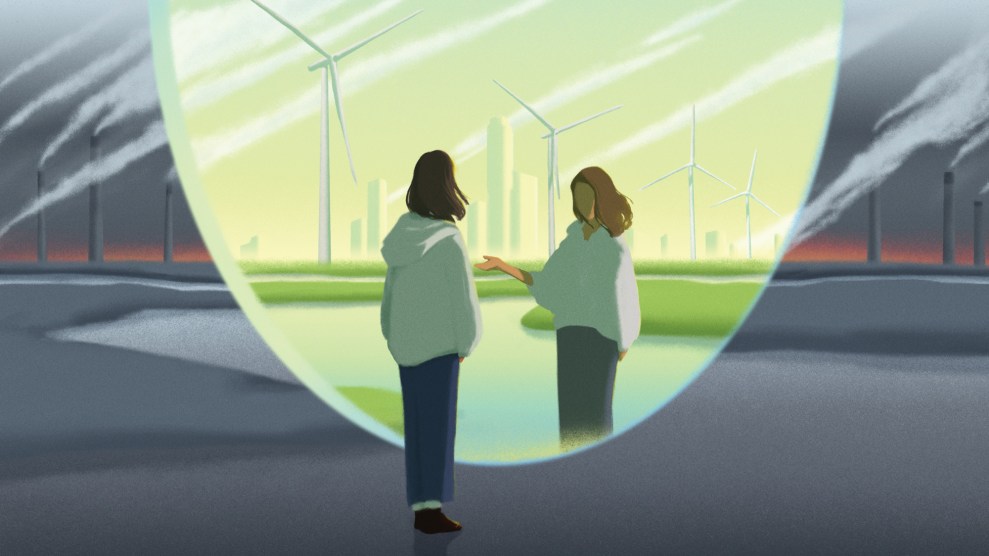Today is International Women’s Day. You’d hardly know it.
Though the IUCN (World Conservation Union) has celebrated by releasing a disturbing report on global warming predicting that the physical, economic, social, and cultural impacts of global warming will jeopardize women far more then men. Just as Hurricane Katrina and the 2004 Indian Ocean Tsunami disproportionately affected women far more then men.
The report, Gender and Climate Change (available here as a PDF), concludes that women are more severely affected by climate change and natural disasters because of their social roles and because of discrimination and poverty. To make matters worse, they’re also underrepresented in decision-making about climate change, greenhouse gas emissions, and, most critically, discussions and decisions about adaptation and mitigation. From the report:
For example, the 20,000 people who died in France during the extreme heat wave in Europe in 2003 included significantly more elderly women than men. In natural disasters that have occurred in recent years, both in developing and in developed countries, it is primarily the poor who have suffered—and all over the world, the majority of the poor are women, who at all levels earn less than men. In developing countries, women living in poverty bear a disproportionate burden of climate change consequences. Because of women’s marginalized status and dependence on local natural resources, their domestic burdens are increased, including additional work to fetch water, or to collect fuel and fodder. In some areas, climate change generates resource shortages and unreliable job markets, which lead to increased male-out migration and more women left behind with additional agricultural and households duties. Poor women’s lack of access to and control over natural resources, technologies and credit mean that they have fewer resources to cope with seasonal and episodic weather and natural disasters. Consequently traditional roles are reinforced, girls’ education suffers, and women’s ability to diversify their livelihoods (and therefore their capacity to access income-generating jobs) is diminished.
The report notes examples from other sources, including this:
An Oxfam Report (March 2005) on the impact of the 2004 Asia Tsunami on women raised alarms about gender imbalances since the majority of those killed and among those least able to recover were women. In Aceh, for example, more than 75 percent of those who died were women, resulting in a male-female ratio of 3:1 among the survivors. As so many mothers died, there have been major consequences with respect to infant mortality, early marriage of girls, neglect of girls’ education, sexual assault, trafficking in women and prostitution. These woes, however, are largely neglected in the media coverage.
And this:
In a study executed on behalf of ACTIONAID in 1993-1994 in the Himalayan region of Nepal, it became clear that environmental degradation has compounded stress within households and pressure on scarce resources. This meant that the pressure on children, particularly girl children, to do more work and at an earlier age was increasing. Girls do the hardiest work, have the least say and the fewest education options. Programmes that concentrate only on sending more girls to school were failing as the environmental and social conditions of the families deteriorated.
Ironically, women also produce less greenhouse gas emissions than men, the report concludes. Flatulence jokes aside, this includes women in the developed world.
In Europe, in both the work and leisure contexts, women travel by car less frequently and over shorter distances, use smaller, energy-saving cars and fly considerably less frequently than men.
Women are over represented as heads of low-income households and under represented in high-income groups. In this respect, income levels play a role in CO2 emissions: the higher the income, the higher the emissions from larger houses with more electrical equipment, bigger cars and so on.
Lower income people, who happen to be—you guessed it—mostly women, also have less access to energy-efficient appliances and homes because these tend to be more costly. Most frustrating of all, women perceive global warming as a more dangerous threat than men do and would do more to address it, given the tools.
Women and men perceive the cause of climate change (including CO2 emissions) differently. In Germany, more than 50 percent of women compared to only 40 percent of men, rate climate change brought about by global warming as extremely or very dangerous. Women also believed very firmly that each individual can contribute toward protecting the climate through his/her individual actions. However, policy planning does not reflect in anyway these perceptions.
By excluding women, the world loses vital input and profound knowledge—knowledge that may prove key to adapting to climate change.
Inuit women in Northern Canada have always had a deep understanding of weather conditions, as they were responsible for assessing hunting conditions and preparing the hunters accordingly. During a drought in the small islands of the Federal States of Micronesia, it was local women, knowledgeable about island hydrology as a result of land-based work, who were able to find potable water by digging a new well that reached the freshwater lens.
The report concludes:
There is a need to refocus the thinking and the debate on energy and climate change to include a human rights perspective. Integrating a rights-based approach to access to sustainable and affordable energy is an approach that will recognise and take into account women’s specific needs and women’s human rights. Current economic models based primarily on privatisation strategies do not include accountability in terms of meeting
people’s basic needs.
The UN has established a website on gender and climate change, where you can learn more, get involved.









